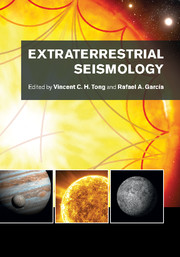Book contents
- Frontmatter
- Contents
- List of contributors
- Preface
- Acknowledgements
- List of abbreviations
- Planetary seismology: High risk, high return
- A bright outlook for helio- and asteroseismology
- Part I Observation and space missions
- Part II Data and physical parameters
- Part III Modeling approaches
- 8 Modeling approaches in asteroseismology
- 9 Modeling approaches in helioseismology
- 10 Modeling approaches in planetary seismology
- Part IV Discoveries of physical structures and processes
- Part V Interdisciplinary research involving planetary and astrophysical sciences
- Part VI Interdisciplinary research involving terrestrial seismology
- References
- Index
8 - Modeling approaches in asteroseismology
from Part III - Modeling approaches
Published online by Cambridge University Press: 05 July 2015
- Frontmatter
- Contents
- List of contributors
- Preface
- Acknowledgements
- List of abbreviations
- Planetary seismology: High risk, high return
- A bright outlook for helio- and asteroseismology
- Part I Observation and space missions
- Part II Data and physical parameters
- Part III Modeling approaches
- 8 Modeling approaches in asteroseismology
- 9 Modeling approaches in helioseismology
- 10 Modeling approaches in planetary seismology
- Part IV Discoveries of physical structures and processes
- Part V Interdisciplinary research involving planetary and astrophysical sciences
- Part VI Interdisciplinary research involving terrestrial seismology
- References
- Index
Summary
As explained Chapters 4 and 5, even basic asteroseismic diagnostics, such as the frequency of maximum power combined with the large frequency separation for solar-like pulsators (e.g., Chaplin et al., 2011a), or the period spacing for high-order gravity-mode pulsators (e.g., Degroote et al., 2010), already lead to values of the global stellar parameters, such as the mass and radius, with a precision far better than that deduced from photometric color indices, spectral lines, or interferometric data. The combination of frequency and period spacings of the dipole mixed modes detected in evolved low-mass stars, allows us to distinguish between red giants with only hydrogen-shell burning or with core-helium burning in addition (Bedding et al., 2011), a property that classical data cannot reveal.
The real benefit of asteroseismic versus classical data becomes even more obvious when modeling the individual oscillation frequencies νnℓm, since they are dependent on, and thus determined by, the details of the interior physics of the stars. Such seismic modeling of the solar oscillation frequencies led to a large step forward in the understanding of the structure of the Sun (Chapter 12), including its interior rotation profile (e.g., Kornilov et al., 2012; Thompson et al., 2003). Likewise, seismic modeling of the oscillation frequencies of other stars offers a unique opportunity to probe the internal physical processes of stars of various birth mass, initial chemical composition, and evolutionary stage. As an example, we shown in Figure 8.1 the observed frequency spectra from three months of Kepler photometry of the binary components and solar analogues 16 Cyg A and B. Finding the correspondence between the observed frequency peaks and those predicted by theory is not only an immensely powerful method to determine the basic fundamental properties of stars, such as their mass, radius, and age, but it also allows us to evaluate standard stellar structure models and improve their input physics.
- Type
- Chapter
- Information
- Extraterrestrial Seismology , pp. 109 - 122Publisher: Cambridge University PressPrint publication year: 2015



